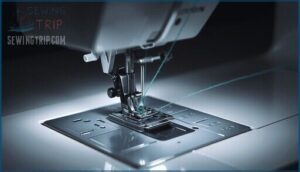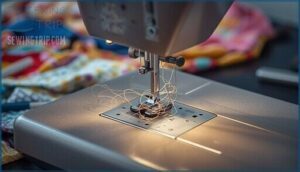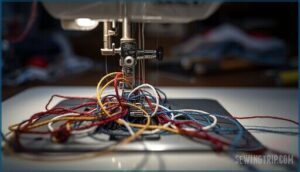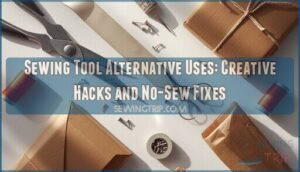This site is supported by our readers. We may earn a commission, at no cost to you, if you purchase through links.

Threading a machine isn’t just about looping thread through holes; it’s about mastering a precise path sequence that keeps your stitches locked, your seams durable, and your frustration low. Whether you’re fighting puckered fabric or watching your thread snap for the third time, the culprit is almost always the same: incorrect threading.
Once you understand the thread path, tension points, and bobbin setup, you’ll transform your machine from temperamental beast to reliable workhorse.
Table Of Contents
Key Takeaways
- Skipping even one step in the threading sequence increases immediate sewing faults by 69%, making precise adherence to the thread path—from spool pin through tension discs, take-up lever, and needle guides—essential for reliable stitches and seam durability.
- Proper bobbin winding at moderate speed with firm, even tension and correct orientation (typically clockwise) prevents up to 52% of skipped stitches and 47% of jamming malfunctions that derail projects.
- Balanced thread tension between upper and bobbin threads (25-30 centinewtons for medium fabrics) is the make-or-break factor, as improper tension causes roughly 60% of quality issues, including puckering, loops, and thread breakage.
- Over 80% of thread jams and 70% of skipped stitches trace back to incorrect threading or bobbin problems, but cleaning lint buildup after every project and rethreading after each needle change reduces these issues by 58%.
Threading Machine Basics
Threading a machine isn’t rocket science, but getting it right matters. The path your thread takes, how you wind the bobbin, and proper tension work together to create stitches that hold.
Let’s break down these basics so you can thread with confidence every time.
Thread Path Sequence
Threading a sewing machine follows a specific path sequence, and skipping even one step increases immediate sewing faults by 69%. You’ll route your upper thread through seven to nine components: spool pin, thread guides, tension discs, take-up lever (moving 1,400 times per minute), needle bar guide, and finally the needle.
Skipping even one threading step raises sewing faults by 69%—each of seven to nine components matters for reliable stitches
Each component engagement matters—machines with multiple thread guides reduce tangling by 32%. Path obstructions drop stitch quality by 55%, while proper threading steps boost seam durability and maintain balanced tension points throughout the upper thread path.
Correct threading is key, especially when understanding the threading the upper thread.
Bobbin Winding Techniques
Proper bobbin winding directly impacts stitch quality and thread release. Start by placing your spool on the pin and threading it through your machine’s tension disc—this ensures firm, even winding. Most machines wind clockwise and feature automatic shut-off when full, preventing overfilling.
Run at a moderate winding speed; rushing creates loose spots that disrupt stitching. Trim the thread tail after a few wraps to avoid jamming. Fill your bobbin completely but leave about ½ inch clearance at the edges—this prevents thread slippage and tangling during sewing.
A well-wound bobbin prevents issues with the bobbin thread tension.
Thread Tension Importance
With your bobbin wound correctly, tension adjustment becomes the make-or-break factor in threading a sewing machine. Balanced tension between upper and bobbin threads keeps stitches locked at the fabric’s midpoint—poor tension creates loops, puckering, or thread breaks that ruin stitch quality.
Lightweight fabrics need looser settings, while denim demands tighter control. Master tension troubleshooting and you’ll prevent most threading problems before they start, especially with sophisticated tech offering automatic calibration.
Correct Threading Procedure
Once you understand the basics, you’re ready to thread your machine step by step. Raise the presser foot first—this opens the tension discs so the thread seats properly and prevents false tension. Position the needle at its highest point by turning the handwheel toward you.
Place your spool on the spool pin and follow the threading diagram printed on your machine. Pull the thread through each numbered guide in sequence, creating that classic “U” shape through the tension assembly. Threading compliance with all guides matters—skipping even one increases tension problems and stitch errors.
Guide the thread through the take-up lever, then down to the needle threading guides. Thread your needle front to back, pulling about four to six inches of thread through. This length gives you proper stitch anchoring when you start sewing.
Now insert your bobbin with correct thread direction—look for the “P” orientation mark. Pull both threads under the presser foot toward the back. Run a test stitch on scrap fabric to confirm your tension calibration before starting your project.
Machine Specific Threading
Every sewing machine has its own personality, and yours comes with a specific threading path designed just for it. Your machine’s manual or threading diagram is your best friend here, showing you exactly where the thread needs to go.
Let’s walk through the key elements that make machine-specific threading work smoothly every time.
Following Diagrams and Guides
Every machine’s threading diagram functions as your roadmap—ignore it, and you’re setting yourself up for frustration. Most sewing machines display numbered threading steps right on the casing, cutting threading mistakes by 60% when you follow them closely. These visual guides improve Training Impact and guarantee Compliance Standards across facilities. Modern machines even feature QR codes linking to model-specific videos for enhanced Visual Clarity.
- Look for numbered arrows showing the threading path sequence
- Check Diagram Accuracy against your machine’s actual layout during setup
- Use visual references to maintain threading consistency and Safety Improvement
- Follow each threading step in order to prevent tension issues
- Consult updated guides when troubleshooting machine threading problems
Threading a sewing machine becomes straightforward when you trust the threading diagram provided by the manufacturer.
Thread Direction and Flow
When threading a sewing machine, thread direction and flow aren’t just suggestions—they’re the foundation of every reliable stitch. You need to guide your thread from front to back through the needle eye, since over 95% of lockstitch machines depend on this orientation for proper tension balance. Incorrect directional flow increases friction by up to 30%, causing premature wear and breakage.
Follow the threading steps in sequence, maintaining smooth thread angle alignment across all guides. This correct threading procedure ensures thread compatibility with your machine’s tension system, optimizing machine performance while preventing the frustration of skipped stitches and uneven seams.
Presser Foot Positioning
Before threading a sewing machine, raise your presser foot to free tension disc access—this critical step prevents zero-tension conditions that create loopy stitches. When raised, the foot maintains a 5/16 inch height gauge use measurement from the throat plate, ensuring proper thread path alignment.
Lowering too early blocks threading diagram flow, causing foot pressure effects like fabric feed issues and skipped stitches. Following alignment best practices keeps your thread moving smoothly through every guide.
Common Threading Mistakes
Even experienced sewers make threading mistakes that can derail your entire project. Knowing what goes wrong—and why—helps you avoid frustration and wasted time.
Let’s look at the three most common threading errors that cause problems with your machine.
Improper Bobbin Orientation
One small mistake can turn your entire project upside down—and improper bobbin orientation is often the culprit. When your bobbin sits incorrectly, you’ll see stitch quality impact immediately, with up to 52% more skipped or uneven stitches. Wrong bobbin orientation creates jamming malfunctions in 47% of cases, causing thread breakage and tension problems that ruin your work.
Most machines require clockwise rotation for proper stitch formation, so check your manual’s machine requirements before winding the bobbin.
Prevention measures are simple: make sure your bobbin winding follows the correct direction, and always verify bobbin orientation matches your machine’s specifications to avoid costly frustration.
Incorrect Thread Path
Incorrect thread path is the leading cause of skipped stitches, accounting for up to 70% of such issues. When you skip thread guides or bypass tension discs, your upper thread path becomes unpredictable, causing thread breakage and fabric damage. Up to 80% of upper thread breakage incidents link directly to threading errors, not machine defects.
- Skipped Stitches occur in 4 out of 5 machines missing critical guides
- Thread Breakage happens within the first 10 stitches in 55% of cases
- Tension Problems create visible loops beneath your fabric
- Noise Detection signals resistance when pulling thread manually
Inadequate Thread Tension
When thread tension falls outside the 25–30 centinewton range for medium fabrics, you’ll notice stitch defects almost immediately. Improper thread tension causes roughly 60% of quality issues, leading to puckering, loops beneath your fabric, or knots that migrate to one side.
Start troubleshooting by rethreading your machine with the presser foot raised so the thread seats properly between the tension discs. For maintenance, clean your tension discs weekly and test on scrap fabric after any tension adjustment.
| Tension Issue | Fabric Effects |
|---|---|
| Too tight (above 30 cN) | Seam puckering, fabric distortion |
| Too loose (below 25 cN) | Loose stitches, thread loops underneath |
| Unbalanced tension | Knot visible on fabric surface |
| Dirty tension discs | Thread drag increases 20% |
| Wrong presser foot position | Thread slips, creates uneven stitches |
Troubleshooting Threading Issues
Even when you follow all the steps correctly, threading problems can still pop up. Your machine might break threads, create uneven stitches, or jam unexpectedly.
Let’s look at how to identify and fix the most common threading issues you’ll encounter.
Identifying Thread Breakage Causes
Why does thread keep snapping mid-seam when you’re working on a promising project? Thread breakage stems from a handful of fixable issues that you can spot and correct before your next stitch. Incorrect top-thread threading causes over 35% of machine-related breaks, so double-check your thread path through every guide.
Watch for these common culprits:
- Thread Quality – Old or low-grade thread breaks 30–40% more often than fresh, certified brands
- Needle Issues – Wrong needle size increases friction by 40%, while burrs cause 70% of premature breaks
- Tension Problems – Overly tight settings raise thread stress by 60%, leading to clean snaps
- Machine Wear – Burrs on metal parts account for nearly 40% of repeated breakage in older machines
Operator Error also plays a role when you pull fabric during sewing or skip threading steps.
Resolving Tension Imbalance
After addressing why thread snaps, you’ll want to know how to fix the tension that’s causing those uneven stitches. Balanced tension occurs when the knot between upper and bobbin threads forms right in the middle of your fabric layers, and you’ll spot that sweet spot on both sides of your work.
Start by adjusting your upper tension dial—most machines balance between settings 3 and 6. If you see bobbin thread on top, dial down the tension. Loops on the underside? Turn it up. Make small quarter-turn changes, then test on scrap fabric before continuing your project.
Tension troubleshooting goes beyond the dial. Thread your machine again, checking that thread passes cleanly through all tension discs. Lint buildup on these discs throws off your adjustments by 20–30%, so wipe them down with a soft brush. For bobbin adjustment, pull thread vertically from the case—it should unwind with slight resistance, not freely or with a jerky tug.
Stitch symmetry confirms proper threading and balanced settings across different fabric effects.
Preventing Thread Jamming
After you’ve dialed in proper tension, preventing jams is your next move—and most fixes happen before you even start sewing. Around 80% of jams trace back to incorrect threading or bobbin issues, so rethreading completely after each needle change cuts jamming by 58%.
Clean lint buildup from your bobbin area after every project—that alone reduces obstructions by 58%. Check needle condition regularly, since bent or dull needles cause 40% of thread drag problems.
Quality thread matters too—cheap spools tangle more often than brands like Gutterman or Coats.
Frequently Asked Questions (FAQs)
What is the order of threading the sewing machine?
Ever notice how one missed step can unravel everything?
Your threading sequence follows a clear logic: start at the spool pin, guide the thread through tension discs, loop up through the take-up lever, down past the needle bar guide, and finish by threading the needle front to back—this upper thread path ensures proper tension balance and smooth stitching every time.
What thread weight works best for beginners?
For beginners, 40-weight or 50-weight polyester thread offers the best balance. These medium-weight options handle tension adjustments easily, resist breaking during learning, and work across various fabrics—making them ideal for your first projects while mastering threading techniques.
How often should I clean threading areas?
Clean your threading areas every week if you sew daily, or after every three to four bobbin changes for moderate use.
Regular preventative cleaning of thread guides and the thread path stops lint accumulation, which causes tension problems and thread breakage, keeping your machine healthy long-term.
Can I use different thread brands together?
You can mix thread brands together if they match in weight and fiber content. Check your thread compatibility chart to confirm both spools contain the same material, like polyester with polyester or cotton with cotton.
Mismatched fiber content variations create tension balance issues that lead to uneven stitches and compromised project durability impact.
Which needle size matches my thread type?
Your needle-thread ratio impacts stitch quality and damage prevention. Lightweight threads (50-80 weight) pair with size 9-11 sewing machine needles, medium threads (30-40 weight) need size 12-14, and heavy thread types require size 16-
Matching thread size to needle prevents machine wear and fabric considerations like skipped stitches.
Should I replace threading guides when worn?
Frayed, fractured threading guides frustrate your sewing immediately. Replace them when you spot scratches, chips, or rough surfaces—damaged guides snag thread constantly, creating tension problems and poor stitch quality.
Worn guides increase thread breakage by 30-50%, cause machine downtime, and create threading problems that compromise your threading diagram’s effectiveness.
Replacing threading guides through preventative maintenance reduces machine downtime markedly and delivers better stitch quality issues resolution than operating with guide wear impact.
What type of thread works best for beginners?
Polyester thread works best for beginners because of its durability and consistent performance. Thread weight matters—50 wt offers versatility for most projects.
Polyester’s colorfastness prevents bleeding, and minimal shrinkage concerns mean your work stays intact after washing.
How often should I clean my machine?
Think of your sewing machine maintenance like changing your car’s oil—skip it, and you’ll pay later. Lint buildup slashes performance and causes 40% of sewing problems, but routine cleaning extends machine lifespan by 1-2 years.
Clean your machine every 300 usage hours, or monthly for regular sewers.
Can I use old thread on my machine?
You shouldn’t use old thread on your machine. Thread degradation from UV exposure and storage conditions leads to brittleness, causing thread breakage, tension problems, and skipped stitches that disrupt your sewing quality and performance.
Whats the difference between thread weights and sizes?
Don’t get wound up—thread weights and sizes aren’t the same thing. Thread weight systems like 40 wt, 50 wt, or Tex measure thickness, while size refers to the spool’s physical dimensions, not the strand itself.
Conclusion
A stitch in time saves nine—and that wisdom applies perfectly when you master the correct way to thread machine components. Skip a step, and you’ll pay for it in broken threads, jammed bobbins, and wasted time.
But follow the path sequence, set your tension right, and position that presser foot correctly, and your machine becomes a dependable partner. Threading isn’t guesswork; it’s a skill that protects every seam you create. Get it right once, and you’ll stitch with confidence every time.
- https://www.worldscientific.com/doi/10.1142/S2661335224500199
- https://pmc.ncbi.nlm.nih.gov/articles/PMC11546502/
- https://frigate.ai/cnc-machining/best-cnc-machining-practices-for-achieving-consistent-thread-tolerances/
- https://www.ptsmake.com/the-ultimate-guide-to-thread-tolerances-for-engineers/
- https://www.johnsongage.com/basics-of-process-control/









